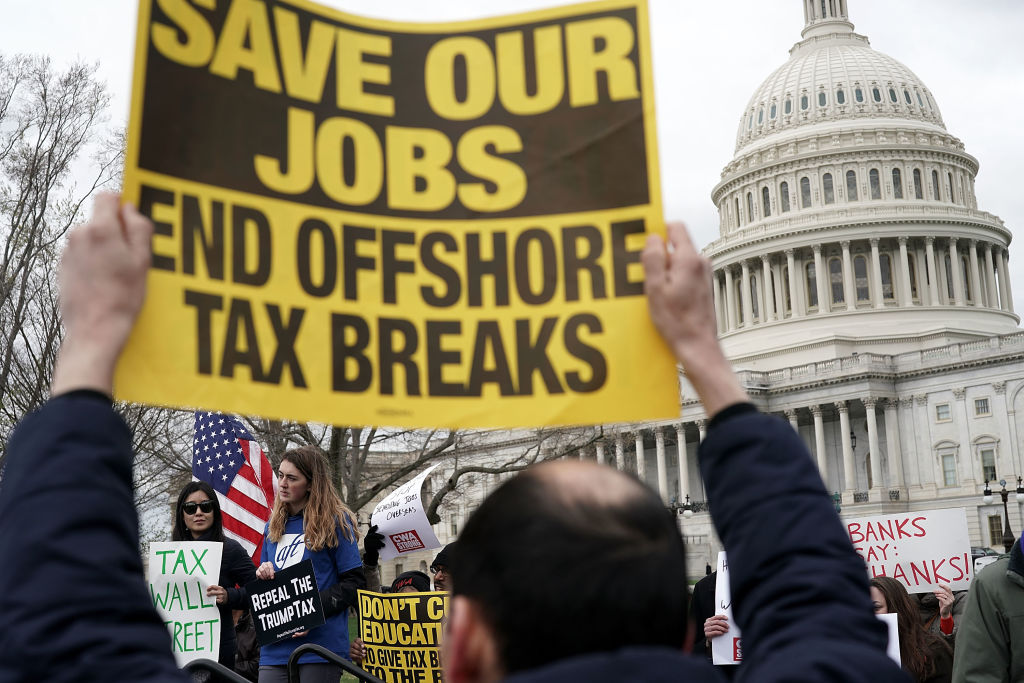Fifty Years of ‘Cut To Grow’: How Changing Narratives around Corporate Tax Policy Have Undermined Child and Family Well-Being
January 23, 2024
By Reuven S. Avi-Yonah, Emily DiVito, Niko Lusiani
Looking back over the past 50 years of corporate tax reforms demonstrates just how entrenched the neoliberal narrative around tax cuts has become in policymaking.
The supremacy of a “cut-to-grow” mentality has made it difficult for a more expansive, progressive vision of tax reform to break through—contributing to a decades-long stalemate in efforts toward real comprehensive corporate tax reform and hindering the government’s ability to make needed investments in child and family well-being policy.
“This paper concludes with reflections on the political economy of taxing corporations, and how a more holistic understanding of the revenue and regulatory roles, in particular, of corporate tax policy might help us overcome what has become a 40-year stalemate in efforts toward real reform.”
Introduction
The United States corporate income tax has been a force for over a century, but in just the last few years it has become one of the most hot-button issues in US politics. The most recent tax reform effort, the Tax Cuts and Jobs Act of 2017 (TCJA), provided a dramatic cut in the corporate tax rate, the elimination of its graduated nature, and many other provisions favoring large corporations and business entities. The Inflation Reduction Act (IRA) of 2022 attempted to reverse some of these provisions by adding a corporate alternative minimum tax (AMT) based on financial reporting by the largest corporations. And a case before the Supreme Court at the time of writing (Moore v. United States) centers on the constitutional meaning of income in a corporate tax provision enacted in the TCJA.
In 2025, many of the central provisions of the TCJA will expire, opening up a significant opportunity for corporate tax reform that improves the lives and well-being of families and children. Though raising taxes on corporations is historically popular, current political discourse around the real opportunity for tax reform in 2025 tends to sell the potential of the corporate tax short.1 The debates over the corporate tax tend to focus, principally, on political opportunities for minimal changes to the law without addressing the crucial importance of the corporate tax in our economy and society. As a tax instrument, the corporate tax has two major goals: to tax the capital income that overwhelmingly flows to the wealthiest households and would otherwise go largely untaxed, and to tax the economic resources available to corporate managers thereby reducing the power of and restricting any potentially harmful activities of corporate management (Avi-Yonah 2004; Clausing 2023). Thus, beyond raising revenue and regulating industries, the corporate tax can help rebalance power in the economy in favor of workers and consumers relative to (disproportionately white) shareholders and business executives.
Historically, there have been two narratives surrounding the corporate tax, each competing for dominance in the cultural and political discourse. From the early 20th century through the 1960s, the predominant narrative on tax reform was that it should be levied to both raise revenue and structure markets. This mentality is evidenced by federal policy of the time. The corporate tax rate was gradually raised from 1 percent (in 1909 when it was first established) to 52.8 percent in 1968, when it accounted for over 25 percent of total federal revenues. During this era, the corporate tax was structured to ensure that it reached wealthy shareholders by, for example, eliminating an exemption for dividends (as the US did in the 1930s) to taxing dividends at the full ordinary income rate (which it did for many years during and following the Great Depression and World War II, at rates as high as 94 percent). Such high rates required enacting a slew of complementary provisions to prevent shareholders from attempting to avoid the full taxation of dividends by converting them to capital gains taxed at a much lower rate.
However, around the 1970s, the dominant narrative on corporate taxation came to be replaced by one that espoused a “cut-to-grow” mentality. Under this view, the thinking went, it was necessary to reduce the corporate tax rate to grow the economy—and that this growth would allow gains to eventually “trickle down” from the rich shareholders to the middle class.
During this time, the corporate tax rate was gradually reduced to 35 percent before it was dramatically cut to 21 percent in 2017. These cuts resulted in corporate tax revenues falling to less than 10 percent of total federal revenues. At the same time, various tax credits (like the investment tax credits), deductions (like accelerated depreciation and expensing), and the rapid increase of corporate profit shifting exclusively benefited business entities and their wealthy executives and shareholders. By 2022, an AMT as low as 15 percent was estimated to raise more than $200 billion because most large corporations were paying less than that on their financial income (Jane G. Gravelle 2023). This proposal has been enthusiastically resisted by corporate owners and executives.
At the same time, as these corporate tax narratives dueled for dominance, the role of government was reconceptualized from providing resources and opportunities for child and family well-being—with the corporate tax as one component of that larger federal effort that includes individual income taxation—toward the market-friendly view that the state’s role in the private sector should be supplanted by the “private family as an economic institution,” which came to be embodied by the “family businesses” that tend to incorporate as (undertaxed) pass-throughs and often rely on the unpaid labor of female family members (Cooper 2017; Cooper 2022).
This mentality functionally calls for a much less active federal apparatus in favor of passive government, serving to monitor (but seldom intervene in) the free market or American families’ ability to access the opportunities it naturally provides them. With this view, the federal government doesn’t need to exercise a strong taxing authority because it also doesn’t need to—and, indeed should not—provide and administer a robust safety net for its citizens. Following this logic, the government should aim to reduce both tax burdens on business entities and their wealthy owners and operators and reduce spending on the public services tax revenues help enable. The result, which has largely borne out in economic and social policymaking of the last several decades, is increased relative tax burdens on low- and middle-income households and decreased ability of those (often Black, brown, and/or nontraditional) families to receive the direct public assistance on which they disproportionately rely.
This report is the final of two from the Roosevelt Institute analyzing the intersection of corporate taxation and child and family well-being policy. The first, titled “A Mapping of the Full Potential of US Corporate Taxation to Enhance Child and Family Well-Being,” aims to establish a holistic framework for assessing the corporate tax through its capacity to raise revenue for public services, balance out unequal distributions of economic resources, regulate economic activity, and, more broadly, build public trust in democracy (DiVito and Lusiani 2024). In it, DiVito and Lusiani demonstrate that, even beyond its revenue-raising potential, strong corporate tax policy is vital to all aspects of a thriving economy—and critical to the well-being of children and families, investment in which is woefully inadequate.
What follows in this report is an assessment, though not exhaustive, of the central worldviews and set of assumptions driving key US corporate tax reform moments in history—and their consequences for the well-being of children and families in the US. Though political narratives of all kinds are never cleanly chronological (and this remains true of those pertaining to corporate taxation and well-being policies), we aim to build on existing understanding of how dominant narratives come to be and how they, to the extent that they do, drive corporate tax policy outcomes in the US. Looking back over the past 50 years of corporate tax reforms demonstrates just how entrenched the neoliberal narrative around tax cuts has become in policymaking. The supremacy of a “cut-to-grow” mentality has made it difficult for a more expansive, progressive vision of tax reform to break through—contributing to a decades-long stalemate in efforts toward real comprehensive corporate tax reform and hindering the government’s ability to make needed investments in child and family well-being policy. As such, this paper concludes with reflections on the political economy of taxing corporations, and how a more holistic understanding of the revenue and regulatory roles, in particular, of corporate tax policy might help us overcome what has become a 40-year stalemate in efforts toward real reform.
1For instance see (Campbell 2009; Thorndike 2021; Gallup, Inc. n.d.).
Presidential Eras and Corporate Tax Policy
This paper traces the transformation of narratives around corporate tax and social welfare policy from the New Deal era to the Reagan, Clinton, W. Bush, Obama, and Trump presidencies, which promoted or retained elements of the harmful “cut-to-grow” idea that cutting corporate taxes helps the economy.
The New Deal Era of Corporate Tax
FDR saw strengthening the corporate tax (as well as the individual income tax) as a way to enable the state to provide for a stronger welfare system and as a way to weaken the large concentrations of wealth and power that had helped plunge the country into the worst financial crisis in US history and had inhibited broad social prosperity.
The 1970s: Reagan Ascendant
The anti-tax-and-spend narratives that came to dominate public and political discourse in the 1980s were set into motion in the decades prior.
The Reagan Years: The Rise of “Cut to Grow”
Perhaps more than any other, President Ronald Reagan leveraged mounting backlash to taxation and government spending to dramatically reduce both, regardless of the consequences to American families.
The Clinton Years: The Politics of Welfare Reform Leave Children and Families Behind
President Bill Clinton, first elected in 1992, was different in party than Reagan, but ultimately adhered to many of the “cut-to-grow” economic and tax assumptions of his Republican predecessor.
The W. Bush Years: The “Bush Tax Cuts” Exacerbate Inequality
The Bush tax cuts can be seen as a continuation of the Reagan era—and, to a degree, Clinton era—commitment to “cut-to-grow” myths.
The Obama Years: Missed Opportunities and Compromise
The story of Obama-era tax policy is one of missed opportunities for reform due to business opposition—at the expense of the public welfare.
The Trump Tax Cuts: A Handout to Corporations and the Wealthy
One of the only economic policies that Donald Trump campaigned on when running for president in 2016 was his tax plan to cut taxes.



